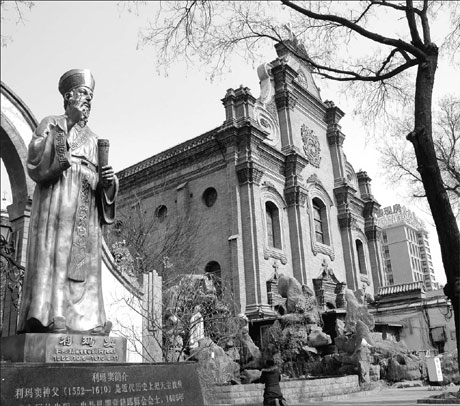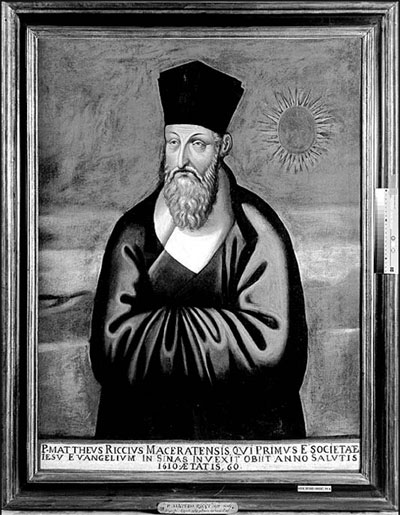Focus
Jesuit who linked Rome with Beijing
By Lu Chang (China Daily)
Updated: 2010-05-28 07:50
 |
Large Medium Small |
|
|
Matteo Ricci, the first Westerner to become 'truly Chinese', changed the way the nation saw the outside world
Though 400 years have passed since his death, Matteo Ricci's tomb in Beijing is still a big draw for visitors worldwide who come to commemorate the great missionary, one of the pioneering carriers of Western science and technology to the Middle Kingdom.
An Italian Jesuit priest, Ricci came to China as a missionary, but he also introduced Western science to the country, endeavored to explain Christianity with Confucian values and established cultural communication between China and the West.
Liang Jun, an expert at Beijing Administrative College who has studied Matteo Ricci for many years, said Ricci enjoys such a good reputation in China because he stepped out of the role as a Jesuit missionary and brought Western science, cartography, mathematics and astronomy to China.
"He actually carried religious belief and scientific and cultural values, helping to create a bridge between China and Italy, and the East and the West," Liang said. "He also changed the way in which ancient Chinese people looked at the outside world and at the same time how the Chinese think of themselves."
Not only does this year mark the 40th anniversary of diplomatic ties between China and Italy, it is also the fourth centenary of Ricci's death.
Li Ma Teu (Ricci's Chinese name), was buried with imperial honors in 1611 in the Beijing Administrative College, which used to be Zhalan Cemetery.
Ricci was born in Macerata, in the east of Italy. He studied theology and law in Rome where he joined the religious order of the Society of Jesus in 1571.
Dedicated to the priesthood, in 1578 Ricci sailed from Lisbon, Portugal, a member of a missionary expedition to Goa, India. Four years later he was sent to Portuguese-controlled Macao, southern China, where he began to learn the Chinese language and customs.
"Unlike some Westerners who wrote about their experience upon just setting foot in China, Ricci threw himself into the society to feel and reflect," Liang said. "After finding China was strongly influenced by traditional ideology, especially Confucian values, he turned to the Confucian classics himself and dressed as a Confucian, even wearing a square piece of cloth on his head."
Ricci was the first Westerner to read the Confucian classics and delve deep into Chinese culture.
Not only called himself a "Western Confucian", he tried to determine the connections between Confucianism and Catholicism and attempted to adopt Catholic rituals to Confucian.
Liang said Ricci was the first Westerner who became "truly Chinese." He could speak and write in Chinese, and he translated the first six books of Euclid's Elements in collaboration with Chinese scholar Xu Guangqi, which was considered at the time to be the rebirth of mathematics in China.
Ricci's first book in Chinese On Friendship was written in 1595 and won him the trust and respect of many Chinese scholars and officials with its clear message of friendship, tolerance and mutual understanding.
In the book, Ricci wrote, "I think without sadness about friends who have died, for when they were alive I held them as if I could lose them. And now that they passed away, I think about them as if they were still alive."
Liang said the thoughts of Ricci are still relevant today and could aid understanding and smooth affairs between two different nations.
"My friend is not another person but my second self, so I shall treat my friend just like me," said Liang quoting from the book.
Ricci made great contributions to Chinese geography, precisely calculating the breadth of China with the help of Western mathematics and surveying and mapping.
Barbara Alighiero, the cultural counselor of Italian embassy in Beijing, said Ricci was the first person who verified to Rome that China and the Cathay written by Marco Polo were the same country and also revealed to the Chinese that the earth was not square but round.
"For the past three centuries, Ricci was nearly forgotten by Italian people," said Alighiero to METRO.
"Right after the death of Matteo Ricci, the Belgium Jesuit, N. Trigault translated Ricci's China Journal from Italian into Latin and published it with his name in German in 1615. Since then the whole of Europe recognized N. Trigault and forgot the real author."
"Matteo Ricci is for culture and spirituality what Marco Polo represents for adventure and enterprise," said Riccardo Sessa, Italian Ambassador to China.
"Now people are realizing the importance of Matteo Ricci and organize all kinds of events every year including concerts, exhibitions and meetings to memorize him."
|
|

